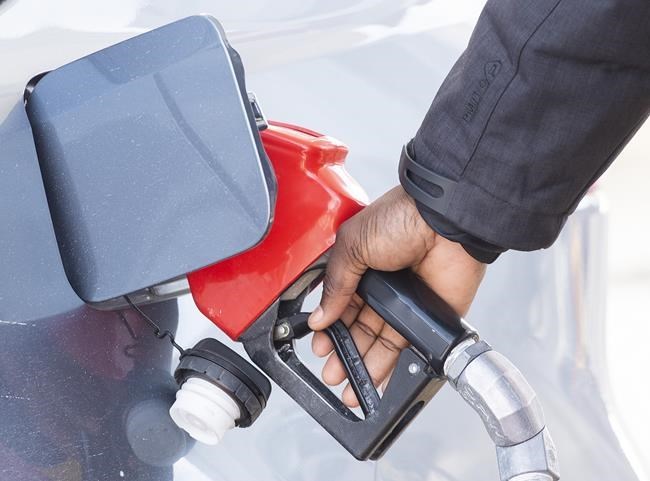OTTAWA — New federal Clean Fuel Regulations will help eliminate millions of tonnes of greenhouse gases over the next eight years and encourage investments in renewable fuels but could drive up the price at the pump for consumers as much as 13 cents a litre, the government's own analysis shows.
The regulations will require primary fuel suppliers — mainly refineries and importers of gasoline and diesel — to cut emissions from the fuels across their life cycle, from extraction through to processing, transportation and end use.
An emissions cap will kick in next July and increase slightly each year through to 2030.
An impact assessment of the new regulations was released Wednesday alongside the final draft of the regulations, which have been in the works since the Liberals' first climate plan in 2016.
The assessment says higher gas prices will have the biggest impact on lower-income families, single mothers and seniors, who are more vulnerable to fluctuations in energy costs and are the least likely to be able to afford alternatives like electric vehicles.
It said the total emissions cut each year from the regulations could be about 18 million tonnes in 2030 if there are no big changes in fuel use, such as a big uptick in electric vehicle use. Incorporating more behavioural changes and less fuel use as a result of the policies could cut emissions more than 26 million tonnes.
On the low end, that means the regulations would account for seven to eight per cent of the emissions cuts Canada needs to make from what they were in 2020, the most recent year for which data is available. On the higher end, it could account for 10 to 12 per cent.
Initially the regulations were going to cover all fuels but Environment Minister Steven Guilbeault said in an interview that a decision was made to refocus it only on gasoline and diesel.
"What this piece of policy or regulation is trying to do is to ensure that the fuel that we burn to move ourselves around is cleaner," he said.
That will happen through actions such as cutting emissions during production through carbon capture systems, blending the final product with cleaner-burning biofuels like ethanol, or more indirect actions such as investing in electric vehicle charging or production and distribution of low-carbon fuels.
Guilbeault said the main purpose of the regulations is to encourage more production of cleaner fuels and he is "confident" that is going to happen.
Andrea Kent, a board member at Renewable Industries Canada and vice-president at Greenfield Global, Canada's largest ethanol producer, said overall there are signs the new regulations will have a positive impact on her industry.
"When you look at a low-carbon fuel standard policy, biofuels are very practical, they're already in use, they're an affordable option and they're also very, very sustainable," she said.
The impact analysis says it will cost between $22.6 billion and $46.6 billion for refineries and other fuel suppliers to comply, or an average of about $151 per tonne of emissions reduced. It suggests the policy could have a $9 billion impact on Canada's GDP, or about 0.3 per cent.
The longer-term effect will be lower costs for low-carbon fuels and higher costs for gasoline and diesel. The impact analysis said gasoline prices could rise between six and 13 cents a litre as a result, adding between $76 and $174 to the cost of filling a car with gasoline each year.
NDP environment critic Laurel Collins called that an "alarming" finding.
"Hard-working Canadian families should not be paying the costs of emission reductions while rich oil and gas companies make record profits," she said.Â
But Dan Woynillowicz, principal at Polaris Strategy, which is a climate change and energy policy consulting firm, said it's not clear how much of the costs will be loaded onto the backs of consumers.
Since 2019, profit margins for refineries have more than doubled. The government's analysis says in June 2019, when pump prices averaged almost $1.22 per litre in Canada, about one-fifth of that went to refineries.Â
In June 2022, with pump prices averaging more than $2.10 per litre, refineries are getting about one-quarter of that.
Woynillowicz said those profits can be used to cover at least some of the costs coming into play associated with these regulations, and he said refineries have to realize that the higher pump prices go, the faster Canadians are going to transition to electric cars and other options.
Right now, they can bump up the price because gas companies have very little competition.
"Refineries are going to have to kind of say, ‘OK, well, we now have competition that we haven't had before so how much of that cost do we actually pass along,’" he said.
Woynillowicz also said the transition away from fossil fuels will eventually protect Canadians from the surge in oil prices we've seen over the last few months. Clean electricity and biofuels are not subjected to the same global market forces as oil is, he said.
This report by The Canadian Press was first published June 30, 2022.
Mia Rabson, The Canadian Press

